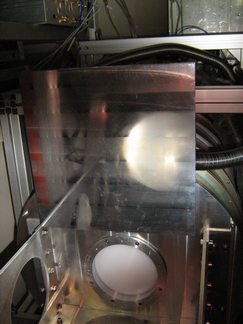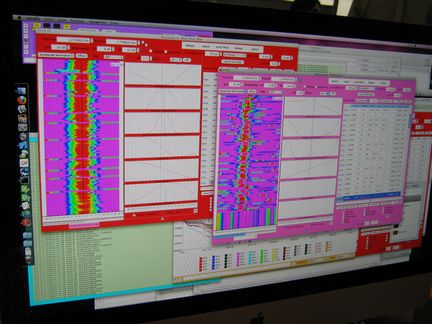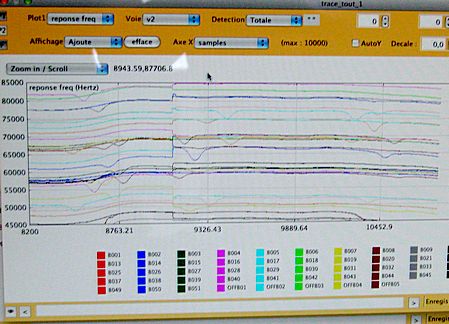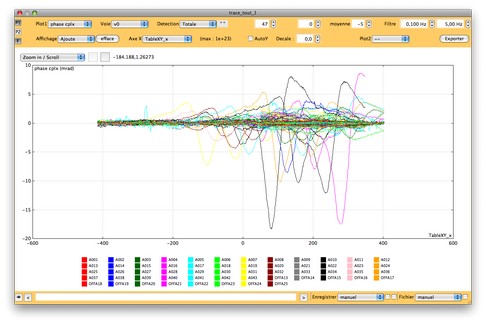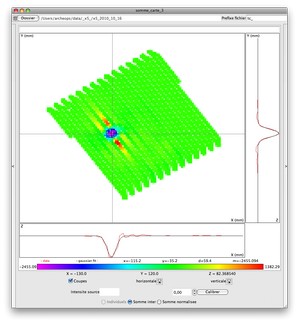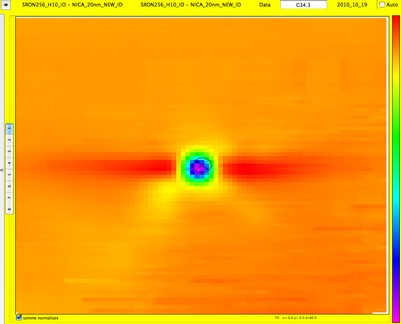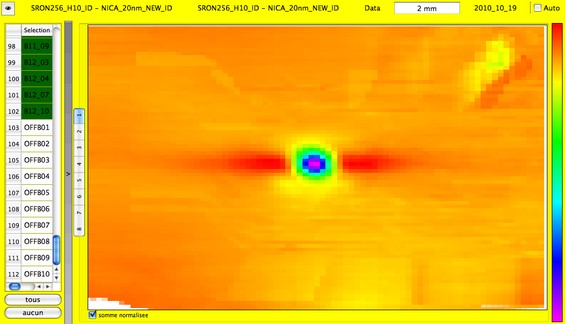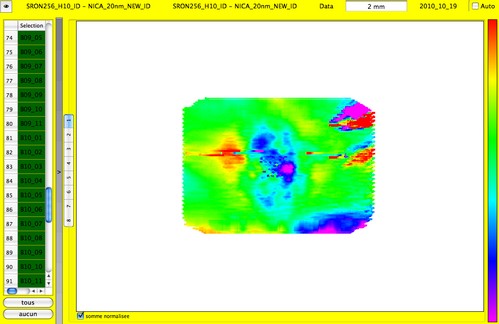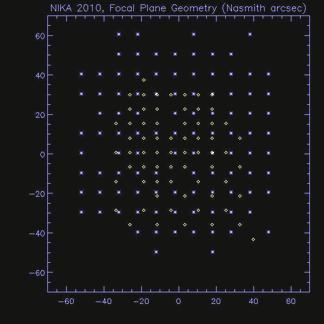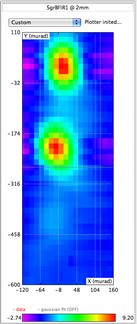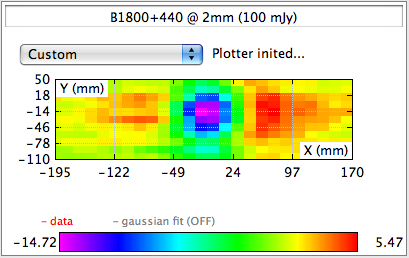|
Size: 64
Comment:
|
Size: 9382
Comment:
|
| Deletions are marked like this. | Additions are marked like this. |
| Line 1: | Line 1: |
| = NIKA run #2 = | = NIKA run #2 (13. - 25. Oct 2010, week 42) = |
| Line 3: | Line 3: |
| [NeelBolometer|Back to the NIKA main page]] | [[NeelBolometer|Back to the NIKA main page]] == Test run plan: 14.10. - 25.10.2010 == [[http://www.iram.fr/IRAMFR/PV/sche/sche.html|Telescope Schedule]] || '''#''' || '''Dates''' || '''Main Task''' || '''Details''' || '''Lead (IRAM / Neel)''' || '''Support''' || || || 13.10. || || Arrival of first visitors in Granada || || || || || 14.10. Thursday || Arrival of truck, mount and cool down || Limited access to Rx-Cabin: 4 hours in afternoon || Samuel / Alain || || || || 15.10. Friday || Cool down / system checks || Limited access to Rx-Cabin: 2 hours in afternoon || Samuel / Alain || || || || 16.10. Saturday || Optical alignment (incl. removal of M3) || Limited access to Rx-Cabin: 2 hours in afternoon || Samuel / Alain || || || || 17.10. Sunday || Bright sources optical model || Limited access to Rx-Cabin: 2 hours in afternoon || Samuel / Alain || || || || 18.10. Monday || Observations ('''T16-10''') || 6h30 - 20h30 || Samuel / Alain || || || || 19.10. Tuesday || Observations ('''T16-10''') || 17h30 - 2h30 || Samuel / Alain || || || || 20.10. We. - 21.10 Th. || Observations ('''T16-10''') || 14h30 - 2h30 || Samuel / Alain || || || || 22.10. Friday || Observations ('''T16-10''') || 9h00 - 21h00 || Samuel / Alain || || || || 23.10. Saturday || Observations ('''T16-10''') || 18h00 - 6h00 || Samuel / Alain || || || || 24.10. Sunday || Observations ('''T16-10''')|| 14h30 - 2h30 || Samuel / Alain || || || || 25.10. Monday || Warm up, dismount || Free Rx cabin for 11h00 (MAMBO-2 operations) || || || [[attachment:NIKArun2_Schedule_Oct2010.htm|color table of the Run schedule]] == Staffing of the test run (DRAFT by CK, 2.9.2010) == The total number of rooms at the Pico is 14. * IRAM/Granada (9 rooms minimum during the week, 7 rooms at weekends): * Operators: J.L.Santarén (day time), F.Damour (night time) (2 rooms) * J.Penalver (1 room, Mon-Wed), S.Sanchez (Wed-Fri) * Astronomers of Duty / Friend of the instrument: D.Riquelme or G.Quintana-Lacaci (1 room) * Receiver group: Dave John or Santiago Navarro ? (1 room) * Computer group: Walter Brunswig or Albrecht Sievers ? (1 room) * Additional 2 rooms are the minimum needed for cooks and cleaning personal. * IRAM/Grenoble: Samuel Leclercq or Markus Roesch or Robert Zylka or Karl Schuster ? (2 at a time, 2 rooms) * Visitors from Neel, LAOG, AIG Cardiff, SRON Utrecht, Groningen: *upto 4 rooms during the week* may be used by the visitors. Double occupancy is an option, but the cooks would need to be informed beforehand of this extra load. If more visitors are essential, they'd need to stay over night in the nearby ski resort Pradollano, e.g. at the hotel Kenia. [[attachment:NikaRun2/Schedule_NIKA_staff_Oct2010.htm|color table of the NIKA staff schedule]] == List of astronomical target (Final by FXD, 14.10.2010) == [[ListAstroTargetNika2|ListAstroTarget]] === Above information plus more details (logistics, preparation of the run, sources list) on the following pdf document === [[attachment:NikaRun2/NIKA-On_Sky_Test_Plan_2010_10.pdf|Test plan 2010 10 (updated 14 Oct 2010)]] ---- == Daily reports == ==== Thursday, Oct 14 ==== Everybody has arrived at the telescope, computers and network installation in the control room done, electrical connection of the instrument checked, NIKA is ready to be lifted to the receiver cabin. 15h-18h: Lift NIKA in the receiver cabin & install it on the optical bench. Alignment with the laser: wrong tilt for M8, will be fixed tonight. Electric checks OK. Pump, start cool down. ||{{attachment:NikaRun2/telescope.jpg}} {{attachment:NikaRun2/NIKA_ready_to_be_lifted.jpg}} {{attachment:NikaRun2/helium_bottles.jpg}} {{attachment:NikaRun2/lift_NIKA.jpg}} {{attachment:NikaRun2/tilt_NIKA.jpg}} {{attachment:NikaRun2/NIKA_on_bench_1.jpg}} {{attachment:NikaRun2/NIKA_on_bench_2.jpg}}|| ==== Friday, Oct 15 ==== The wrong tilt of M8 was corrected during the night thanks to the addition of small aluminum support plates (see picture below). We simulated in Zemax the effect of several millimeter and tenth of degree error in the position of M8 and showed insignificant increase of aberrations. The helium consumption is at least twice higher than expected, maybe due to a small thermal shortcut between the 77K and 4K stages. For the moment we can live with that, let see how it evolve with time. Detectors are cold in the morning and show resonances ! On the picture below the resonances of the 2mm array appear on the red-background window and the 1mm array in the pink-background window. At 14h we go in the cabin to re-install the NIKA mirrors, do the laser alignment, change the helium bottles. Then we perform two scans on Mars. Beside a very fluctuating background due to a cloudy sky, we see it ! Mars appear as little bumps on the time-traces on the picture below of an orange background window. We give back the telescope to the next heterodyne project, and start working on these first light data. ||{{attachment:NIKA_optics_aligned.jpg}} {{attachment:curved_M8_tilt_corrected.jpg}} {{attachment:NIKA_entrance_window.jpg}} {{attachment:resonances_on_both_arrays.jpg}} {{attachment:first_light_on_Mars.jpg}}|| ==== Saturday, Oct 16 ==== Good news: the helium consumption is not as bad as we feared, it takes actually more than 12h between 2 refills, so there no problem at all. Work on software (data acquisition CAMADIA, log files, timing questions...). Observations in the afternoon starts with Saturn: it's there, it's nice and apparently where we expect it to be. Track and scans on Saturn, Mars, 3C345, 3C273. Fine tunings on CAMADIA necessary but observations looks globally pretty nice at least on the time traces (see for example Mars traces below). Too bad it was mostly cloudy. The two last days the clouds arrived in the afternoon, so tomorrow we'll take a morning slot hoping to test the instrument on a better sky (C.Thum and PI's from the project scheduled in the morning have been informed). Work on the quick look data processing of CAMADIA, produce the first map in the evening. The image below show a scan on Mars on one pixel and on 64 pixels of the 2mm array, the orange traces on each side of mars are due to the low-pass causal filter used to suppress mostly the sky noise. Most pixels of both arrays see the sources. ||{{attachment:Mars_traces.jpg}} {{attachment:Mars_scan_1pix.jpg}} {{attachment:Mars_scan_64pix.jpg}}|| ==== Sunday, Oct 17 ==== Spend the 2 hours observing slot on 3C273. Track, scans, focus, different sizes of scans. Source appears nicely (pictures will be posted latter). Work on understanding the data stream broadcast by the telescope control system via Elvin and reconstruct the pixels positions (remark: the 2 seconds delay we had in the data since 1st run has been identified: NCS broadcast the timing and some position data 2 seconds before they become true). ==== Monday, Oct 18 ==== Start observations at 6h30 (4h30 UT). Put focus on yesterday's optimum (2.5mm). Track and scans on 3C84, FTTau, 3C84 again, M82, B0954+658, B1039+811, IRC10216. At 8h30 UT try different Nasmyth offset correction and track and scans on 3C273, then refine focus (still on 3C273) -> final values are -27 21 on Nasmyth offset, and -2mm on focus. Track and scan Arp220. Track and scan on Mars -> pointing OK @ 2-3" precision. 1st rough deduction from Mars T, size and S/N -> ~5mK/Hz^0.5 on 2mm array (~4x better than run #1). track and scan on NRAO530, 1749+096, K3-50A, MWC349, WR147, CygA, CasA. Finish the 14h observing slot with a skydip. (pictures will be posted latter...). ==== Tuesday, Oct 19 ==== Start observations at 19h30 (2 hours after scheduled time due to spikes investigation on heterodyne receiver). Track and scans on G34.3, MWC349, IRC10420, Uranus, Ganymede Callisto and Io, Neptune. 21h30: Skydip. Track and scans on 3C454.3, PSS2322+1944, Crab, GMAur. In the meantime, continue work on coordinates transformations, reconstruction of pixels positions, data processing and reduction. ||{{attachment:G34_3.jpg}} {{attachment:NEPTUNE.jpg}} {{attachment:CRAB.jpg}}|| Images: G34.3, Neptune, Crab (quick look images: obtained with a crude causal filter). ==== Tuesday, Oct 20 ==== Start observations at 17h15 (2h45m after schedule due to continuation of heterodyne spikes investigation). Track and scans on Mars, Sgr B2 (FIR1), 3C345. Try to test acquisition with wobbler (On-Off) => wobbler problems ! Track and scans on B1800+440, CL0016+16 (many scans on that one, "re-do" resonances every ~40min). Skydip @ 22h34. Try again wobbler => impossible to make it work ! Track and scans on 3C454.3, Uranus, MWC349, DR21. Observations still ongoing at the time I'm writing the report. In the meantime, still working on coordinates transformations ! (observing Sgr B2 at its highest elevation (south) we conclude our calculation of the parallactic angle to transform Az El to Rad Dec was correct, though not = PARANGLE in the IMB-fits...). ||{{attachment:FocalPlane_2arrays_in_sky.jpg}} {{attachment:SgrB2FIR1.jpg}} {{attachment:B1800_440.png}}|| Images: Projection in the sky of the working pixels of the 1mm array (orange circles) and 2mm array (violet dots), Sgr B2 (FIR1), B1800+440. |
NIKA run #2 (13. - 25. Oct 2010, week 42)
Test run plan: 14.10. - 25.10.2010
# |
Dates |
Main Task |
Details |
Lead (IRAM / Neel) |
Support |
|
13.10. |
|
Arrival of first visitors in Granada |
|
|
|
14.10. Thursday |
Arrival of truck, mount and cool down |
Limited access to Rx-Cabin: 4 hours in afternoon |
Samuel / Alain |
|
|
15.10. Friday |
Cool down / system checks |
Limited access to Rx-Cabin: 2 hours in afternoon |
Samuel / Alain |
|
|
16.10. Saturday |
Optical alignment (incl. removal of M3) |
Limited access to Rx-Cabin: 2 hours in afternoon |
Samuel / Alain |
|
|
17.10. Sunday |
Bright sources optical model |
Limited access to Rx-Cabin: 2 hours in afternoon |
Samuel / Alain |
|
|
18.10. Monday |
Observations (T16-10) |
6h30 - 20h30 |
Samuel / Alain |
|
|
19.10. Tuesday |
Observations (T16-10) |
17h30 - 2h30 |
Samuel / Alain |
|
|
20.10. We. - 21.10 Th. |
Observations (T16-10) |
14h30 - 2h30 |
Samuel / Alain |
|
|
22.10. Friday |
Observations (T16-10) |
9h00 - 21h00 |
Samuel / Alain |
|
|
23.10. Saturday |
Observations (T16-10) |
18h00 - 6h00 |
Samuel / Alain |
|
|
24.10. Sunday |
Observations (T16-10) |
14h30 - 2h30 |
Samuel / Alain |
|
|
25.10. Monday |
Warm up, dismount |
Free Rx cabin for 11h00 (MAMBO-2 operations) |
|
|
color table of the Run schedule
Staffing of the test run (DRAFT by CK, 2.9.2010)
The total number of rooms at the Pico is 14.
- IRAM/Granada (9 rooms minimum during the week, 7 rooms at weekends):
- Operators: J.L.Santarén (day time), F.Damour (night time) (2 rooms)
- J.Penalver (1 room, Mon-Wed), S.Sanchez (Wed-Fri)
- Astronomers of Duty / Friend of the instrument: D.Riquelme or G.Quintana-Lacaci (1 room)
- Receiver group: Dave John or Santiago Navarro ? (1 room)
- Computer group: Walter Brunswig or Albrecht Sievers ? (1 room)
- Additional 2 rooms are the minimum needed for cooks and cleaning personal.
- IRAM/Grenoble: Samuel Leclercq or Markus Roesch or Robert Zylka or Karl Schuster ? (2 at a time, 2 rooms)
- Visitors from Neel, LAOG, AIG Cardiff, SRON Utrecht, Groningen: *upto 4 rooms during the week* may be used by the visitors. Double occupancy is an option, but the cooks would need to be informed beforehand of this extra load. If more visitors are essential, they'd need to stay over night in the nearby ski resort Pradollano, e.g. at the hotel Kenia.
color table of the NIKA staff schedule
List of astronomical target (Final by FXD, 14.10.2010)
Above information plus more details (logistics, preparation of the run, sources list) on the following pdf document
Test plan 2010 10 (updated 14 Oct 2010)
Daily reports
Thursday, Oct 14
- Everybody has arrived at the telescope, computers and network installation in the control room done, electrical connection of the instrument checked, NIKA is ready to be lifted to the receiver cabin.
15h-18h: Lift NIKA in the receiver cabin & install it on the optical bench. Alignment with the laser: wrong tilt for M8, will be fixed tonight. Electric checks OK. Pump, start cool down.
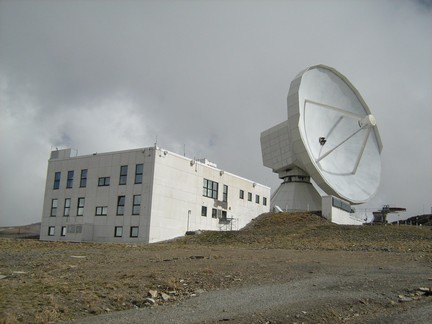
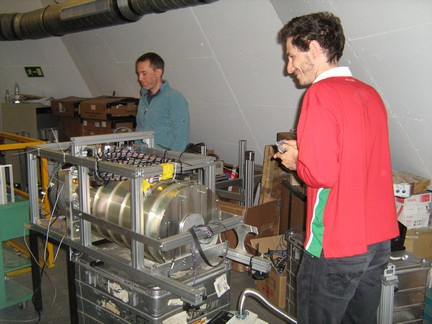
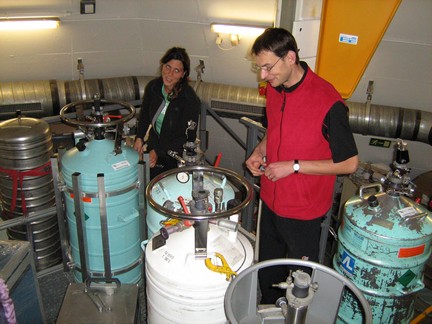
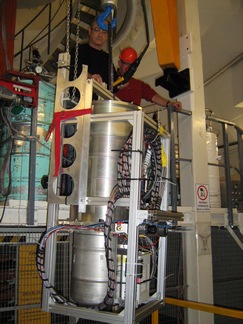
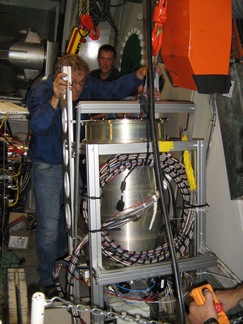
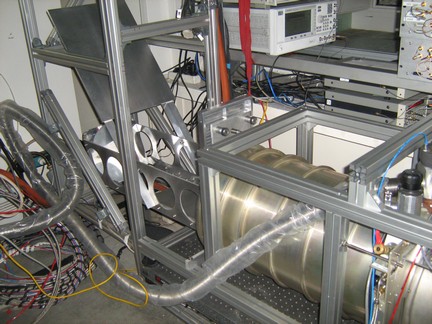
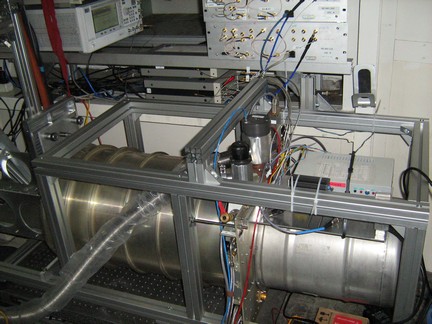
Friday, Oct 15
- The wrong tilt of M8 was corrected during the night thanks to the addition of small aluminum support plates (see picture below). We simulated in Zemax the effect of several millimeter and tenth of degree error in the position of M8 and showed insignificant increase of aberrations. The helium consumption is at least twice higher than expected, maybe due to a small thermal shortcut between the 77K and 4K stages. For the moment we can live with that, let see how it evolve with time. Detectors are cold in the morning and show resonances ! On the picture below the resonances of the 2mm array appear on the red-background window and the 1mm array in the pink-background window. At 14h we go in the cabin to re-install the NIKA mirrors, do the laser alignment, change the helium bottles. Then we perform two scans on Mars. Beside a very fluctuating background due to a cloudy sky, we see it ! Mars appear as little bumps on the time-traces on the picture below of an orange background window. We give back the telescope to the next heterodyne project, and start working on these first light data.
|
Saturday, Oct 16
- Good news: the helium consumption is not as bad as we feared, it takes actually more than 12h between 2 refills, so there no problem at all. Work on software (data acquisition CAMADIA, log files, timing questions...). Observations in the afternoon starts with Saturn: it's there, it's nice and apparently where we expect it to be. Track and scans on Saturn, Mars, 3C345, 3C273. Fine tunings on CAMADIA necessary but observations looks globally pretty nice at least on the time traces (see for example Mars traces below). Too bad it was mostly cloudy. The two last days the clouds arrived in the afternoon, so tomorrow we'll take a morning slot hoping to test the instrument on a better sky (C.Thum and PI's from the project scheduled in the morning have been informed). Work on the quick look data processing of CAMADIA, produce the first map in the evening. The image below show a scan on Mars on one pixel and on 64 pixels of the 2mm array, the orange traces on each side of mars are due to the low-pass causal filter used to suppress mostly the sky noise. Most pixels of both arrays see the sources.
|
Sunday, Oct 17
- Spend the 2 hours observing slot on 3C273. Track, scans, focus, different sizes of scans. Source appears nicely (pictures will be posted latter). Work on understanding the data stream broadcast by the telescope control system via Elvin and reconstruct the pixels positions (remark: the 2 seconds delay we had in the data since 1st run has been identified: NCS broadcast the timing and some position data 2 seconds before they become true).
Monday, Oct 18
Start observations at 6h30 (4h30 UT). Put focus on yesterday's optimum (2.5mm). Track and scans on 3C84, FTTau, 3C84 again, M82, B0954+658, B1039+811, IRC10216. At 8h30 UT try different Nasmyth offset correction and track and scans on 3C273, then refine focus (still on 3C273) -> final values are -27 21 on Nasmyth offset, and -2mm on focus. Track and scan Arp220. Track and scan on Mars -> pointing OK @ 2-3" precision. 1st rough deduction from Mars T, size and S/N -> ~5mK/Hz^0.5 on 2mm array (~4x better than run #1). track and scan on NRAO530, 1749+096, K3-50A, MWC349, WR147, CygA, CasA. Finish the 14h observing slot with a skydip. (pictures will be posted latter...).
Tuesday, Oct 19
- Start observations at 19h30 (2 hours after scheduled time due to spikes investigation on heterodyne receiver). Track and scans on G34.3, MWC349, IRC10420, Uranus, Ganymede Callisto and Io, Neptune. 21h30: Skydip. Track and scans on 3C454.3, PSS2322+1944, Crab, GMAur. In the meantime, continue work on coordinates transformations, reconstruction of pixels positions, data processing and reduction.
|
Images: G34.3, Neptune, Crab (quick look images: obtained with a crude causal filter).
Tuesday, Oct 20
Start observations at 17h15 (2h45m after schedule due to continuation of heterodyne spikes investigation). Track and scans on Mars, Sgr B2 (FIR1), 3C345. Try to test acquisition with wobbler (On-Off) => wobbler problems ! Track and scans on B1800+440, CL0016+16 (many scans on that one, "re-do" resonances every ~40min). Skydip @ 22h34. Try again wobbler => impossible to make it work ! Track and scans on 3C454.3, Uranus, MWC349, DR21. Observations still ongoing at the time I'm writing the report. In the meantime, still working on coordinates transformations ! (observing Sgr B2 at its highest elevation (south) we conclude our calculation of the parallactic angle to transform Az El to Rad Dec was correct, though not = PARANGLE in the IMB-fits...).
|
Images: Projection in the sky of the working pixels of the 1mm array (orange circles) and 2mm array (violet dots), Sgr B2 (FIR1), B1800+440.



